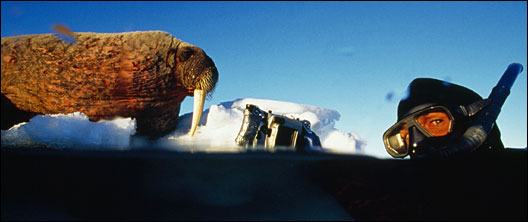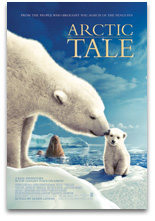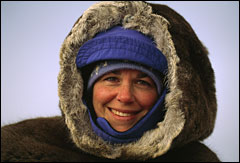
After the surprise success of March of the Penguins in 2005 — a film about, well, penguins … marching — it’s pretty clear that people like movies about cute animals in cold places. So it’s no surprise that National Geographic Films, the company behind Penguins, is back this summer with a new movie documenting the lives of Arctic creatures, this time with a climate-change bent.
Arctic Tale follows a polar bear cub named Nanu and a walrus calf named Seela as they come of age in a melting world. With Queen Latifah narrating, the film follows the two animals from birth to parenthood. The animals in the film are actually composites of several animals filmed over the course of the more than 10 years that the filmmakers, husband and wife team Adam Ravetch and Sarah Robertson, spent in the Arctic. That’s because, says Robertson, “It would be impossible to follow a single animal for that amount of time.”

Photo: Paramount Classics
Though Ravetch and Robertson say they didn’t set out to make a film about climate change, it became an unavoidable part of the story as they watched animals cling to diminishing ice, hunt for increasingly scarce food, and struggle to survive as their Arctic habitat melted beneath them.
In addition to the melty message and the cute, fuzzy factor, the film also features music from Ben Harper, Brian Wilson, Aimee Mann, and The Shins, earning it some points for hipness. The movie’s already gotten play at major film festivals; it opens in select cities on July 25 and everywhere else in August.
Grist recently chatted with the filmmaking duo by telephone to get some insight on the new project, making movies in the Arctic, and why critters make for good storytellers.
What was the genesis of this film?

Adam Ravetch.
Photo: Arctic Bear Productions
Ravetch: Sarah and I have been up in the Arctic over about the last 15 years, focusing a lot on the walruses and polar bears, well before we got any interest [in this film] from anyone at all. When I was diving with whales, I was told by a local guy that if a walrus were to pop up, I should get up out of the water because the animal could hold me against my will and knock my head off with one smack of its tusk and suck my brains out. You’d think this is something that would deter me, but Sarah and I were young, ambitious photographers looking for a region of the world that was relatively little known. We realized at that moment that here was an opportunity.
As we stayed with and followed walruses, we found polar bears too, and we found that they both have a three-year investment in their young to teach them everything they need to know in order for the young to be able to survive. And that’s when we really knew that we had two great characters that we could follow through their lives.
How did you end up in the Arctic in the first place?
Ravetch: Sarah and I met working on a television series. I was an underwater cinematographer and Sarah was a writer. That all came to an end in 1990, and we both became attracted to the Arctic and decided that we wanted to make our own films.
So you just left Los Angeles and decided you wanted to go hang out in the Arctic for a while?
Robertson: Yeah, basically.
Ravetch: I’m from Los Angeles, Sarah’s from Canada, and we were actually living in Venice Beach when our first film came through. In 10 days we moved everything to Canada and boom, we were up in the Arctic making our first film. We were working on television pieces with National Geographic for a few years, and all along we were collecting Arctic footage. So it was about four years ago in conjunction with National Geographic that we thought, “Hey, we should be putting this Arctic story that we have up on the big screen.” Obviously, after March of the Penguins, that became very viable very quickly.
So what was the process of making the film?
Ravetch: Up in the Arctic [there is] an ice season and then there’s this brief summer where the ice breaks up and disappears. And in the beginning when we first found this remarkable scene of a mother walrus hugging and kissing her young calf, we decided we would start in the Arctic in winter time and cover a newborn walrus, and we’d stay up there for months at a time and take maybe a two week break here or there. We’d keep going until the ice disappeared, and then we would follow them to their summer grounds.
This was the pattern that we followed in the very beginning, but then over the years, the ice began breaking up earlier than ever before and re-forming way later than ever before, and that’s when the climate-change theme started to enter our minds, as we started seeing the animals making remarkable decisions and trying to survive.
So climate change wasn’t initially a part of this story? How did you make it a part of the movie?

Sarah Robertson.
Photo: Arctic Bear Productions
Robertson: We’ve seen global warming, especially over the last four or five years, so we have been fascinated to see what we’re thinking of as adaptations in the animals, how they are responding and making decisions. We want to celebrate that remarkable capacity, and that’s definitely what we’ve done here. As far as making a strong climate-change story, we didn’t want to come back and show a winter wonderland, a paradise where everyone is happy, when we’d been experiencing so much change in this environment for so long.
Ravetch: Climate change, from the very first time that we witnessed it, was always something on our minds, and [we decided that] if we got this to the big screen, we weren’t going to sugarcoat it.
How does using animals to tell a story affect how audiences relate to the subject matter?
Robertson: We have a strong narrative that affects the audience because it’s so here and now. It’s great in that you’re able to see animals make choices and decisions, and surprisingly enough, their choices and decisions are often very human-like. The walruses live in families, and they exhibit a lot of devotion to each other. I think people project a lot of their own stuff onto these animals, which I think is interesting. I think people react to animal films in a much different way than they do to other films.
What’s the message that you hope moviegoers will walk away with after seeing your film?
Ravetch: Most importantly, it’s that we’re hopeful about the animals and about their future. Certainly, we’re concerned about climate change, but it’s really a metaphor for us humans that, like Nanu and like Seela, we have to also take risks and make bold decisions to change the way we live in an era of climate change. It’s a message about animals, but it’s a bigger message about us.

